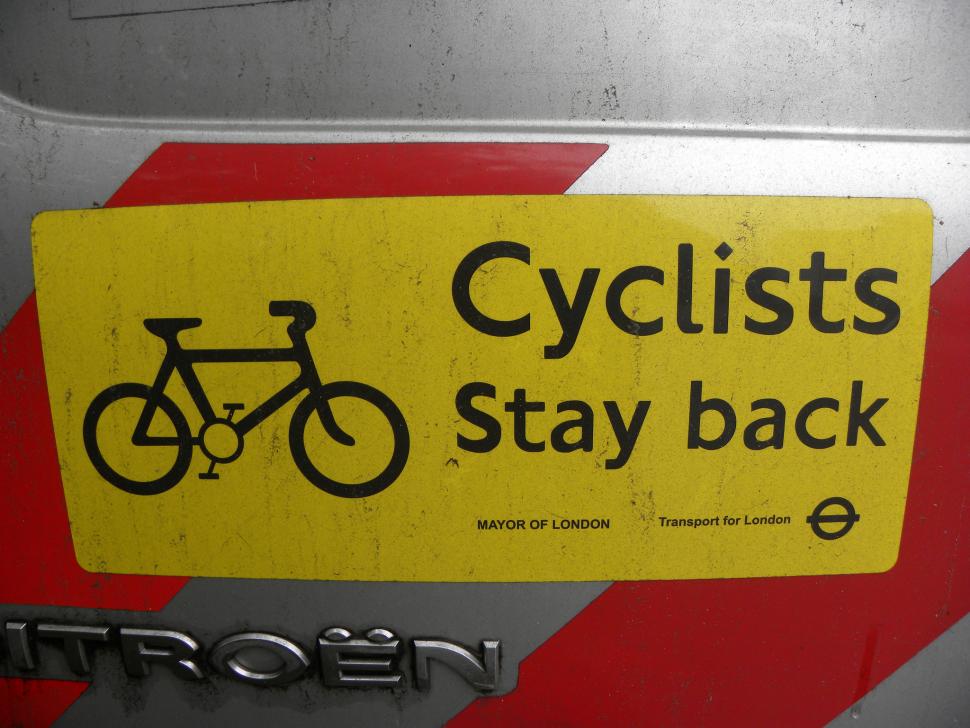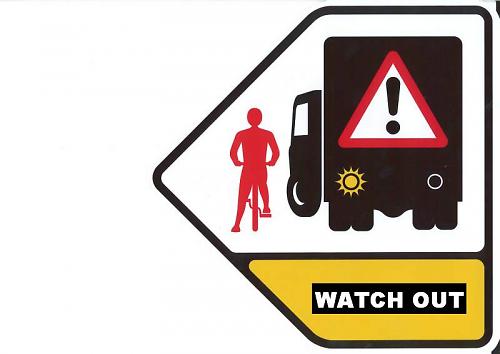- News
- Reviews
- Bikes
- Accessories
- Accessories - misc
- Computer mounts
- Bags
- Bar ends
- Bike bags & cases
- Bottle cages
- Bottles
- Cameras
- Car racks
- Child seats
- Computers
- Glasses
- GPS units
- Helmets
- Lights - front
- Lights - rear
- Lights - sets
- Locks
- Mirrors
- Mudguards
- Racks
- Pumps & CO2 inflators
- Puncture kits
- Reflectives
- Smart watches
- Stands and racks
- Trailers
- Clothing
- Components
- Bar tape & grips
- Bottom brackets
- Brake & gear cables
- Brake & STI levers
- Brake pads & spares
- Brakes
- Cassettes & freewheels
- Chains
- Chainsets & chainrings
- Derailleurs - front
- Derailleurs - rear
- Forks
- Gear levers & shifters
- Groupsets
- Handlebars & extensions
- Headsets
- Hubs
- Inner tubes
- Pedals
- Quick releases & skewers
- Saddles
- Seatposts
- Stems
- Wheels
- Tyres
- Health, fitness and nutrition
- Tools and workshop
- Miscellaneous
- Buyers Guides
- Features
- Forum
- Recommends
- Podcast
 Cyclists stay back sticker (CC licensed image by happy days photos and art:Flickr)
Cyclists stay back sticker (CC licensed image by happy days photos and art:Flickr)Cyclists’ organisations unite against ‘stay back’ stickers
Cycling and road safety organisations have called on Transport for London to remove ‘Cyclists Stay Back’ stickers from its vehicles and to tell operators such as Hackney cab owners not to attach them.
The demand comes in a joint statement from the Road Danger Reduction Forum, CTC, London Cycling Campaign, RoadPeace and the Association of Bikeability Schemes.
The stickers have angered many cyclists who see them as putting responsibility for cycling safety on the victims and potential victims of driver carelessness, and as implying that cyclists are second-class road users who should defer to motor vehicles.
Those two points make up the first of the organisations’ comments about the ‘stay back stickers’, which in full are:
-
The ‘cyclists stay back’ wording is not acceptable for use on any vehicle, because of its implication that cyclists are second-class road users who should defer to motor vehicle users.
It also undermines the responsibility of drivers of such vehicles to use their nearside mirrors as required by the Highway Code in Rules 159,161,163, 169, 179, 180, 182, 184, and 202.
Non-use of nearside mirrors is associated with a significant proportion of incidents where cyclists are hit by motor vehicles. - It is not appropriate to have stickers aimed at cyclists on the back of any vehicle smaller than a heavy goods vehicle.
- Stickers are appropriate on the rear of high-cab lorries, because of these vehicles’ blind areas, and the resultant danger to other road users.
- Stickers on lorries should be worded as warnings rather than commands, with appropriate graphics. A suitable graphic [below] is attached.

The organisations have therefore called for the stickers to be removed from all vehicles except high-cab lorries by the end of March, and for more appropriate stickers to be designed for use on London buses and to replace the stickers currently on high-cab lorries.
Perhaps more importantly, the five bodies have taken the opportunity to reiterate what they see as a far better long-term solution to the problem of cyclist deaths and serious injuries in London caused by HGVs. Calling stickers, “literally, a sticking-plaster solution”, the five groups have called for TfL to promote the use of lorries that do not have blind spots around the cab, to engineer the highway to reduce potential conflict, and to ensure drivers are trained to check their mirrors properly when turning or changing lane.
The demands in full are:
- FORS [Fleet Operator Recognition Scheme] to instruct their members to remove ‘cyclists stay back’ stickers from all vehicles except high-cab heavy goods vehicles, by the end of March.
- London Buses to instruct operators to remove ‘cyclists stay back’ stickers from all buses, until such time as a more appropriate design and wording is agreed with cycling organisations, by the end of March.
- TfL to inform all other vehicle operators, such as Hackney carriages (London Taxi Drivers Association etc.) that TfL do not want such stickers to be used on their vehicles, by the end of March.
- TfL to develop and produce a more appropriate sticker for heavy goods vehicles, similar to the one attached to this statement, and agree the design and wording with cycling organisations, by the end of May.
- TfL to supply the new sticker to freight operators, with instructions only to use it on high-cab lorries. This should be in widespread use by the end of August, with no ‘cyclists stay back’ stickers remaining after this date.
- TfL to invest in designing and promoting use of lorries that do not have blind spots around the cab. Stickers are, literally, a sticking-plaster solution. The long-term solution includes designing out the source of the danger by engineering lorries to reduce or eliminate the possibility of cyclists and pedestrians being crushed in collisions with them, engineering the highway to reduce potential conflict, eliminating lorry driver “blind spots”, and by training drivers to check their mirrors properly when turning or changing lane.
John has been writing about bikes and cycling for over 30 years since discovering that people were mug enough to pay him for it rather than expecting him to do an honest day's work.
He was heavily involved in the mountain bike boom of the late 1980s as a racer, team manager and race promoter, and that led to writing for Mountain Biking UK magazine shortly after its inception. He got the gig by phoning up the editor and telling him the magazine was rubbish and he could do better. Rather than telling him to get lost, MBUK editor Tym Manley called John’s bluff and the rest is history.
Since then he has worked on MTB Pro magazine and was editor of Maximum Mountain Bike and Australian Mountain Bike magazines, before switching to the web in 2000 to work for CyclingNews.com. Along with road.cc founder Tony Farrelly, John was on the launch team for BikeRadar.com and subsequently became editor in chief of Future Publishing’s group of cycling magazines and websites, including Cycling Plus, MBUK, What Mountain Bike and Procycling.
John has also written for Cyclist magazine, edited the BikeMagic website and was founding editor of TotalWomensCycling.com before handing over to someone far more representative of the site's main audience.
He joined road.cc in 2013. He lives in Cambridge where the lack of hills is more than made up for by the headwinds.
Latest Comments
- Simon E 12 min 27 sec ago
Three further incidents this week. What a bonanza!...
- slc 23 min 2 sec ago
The Cugel I knew typically prevailed on others to prepare food. But I was always curious about the porridge of drist and raisins enjoyed on the...
- Freddy56 1 hour 8 min ago
"It'd appear the sportive organizer is particularly uncaring"...
- kingleo 1 hour 21 min ago
Cyclists have been riding in Bister for about 150 years, and now all of a sudden they are a great danger to pedestrians.
- the little onion 1 hour 48 min ago
I didn't remove the sound because I didn't think that it mattered - quite clearly the swearing was in reaction to an act of frankly horrid...
- Nigel_2003 2 hours 35 min ago
Know how the limiter screws on your derailleur work and use the right ones to keep chain on a manageable cog at the back and/or chainring at the...
- Freddy56 2 hours 58 min ago
Story one: "Here is all the deals at 50% off."...
- andystow 3 hours 12 min ago
Front wheel trued and tensioned last night. I think it took me well over an hour.
- quiff 3 hours 35 min ago
From the article above.
Add new comment
91 comments
Something like this? forgive my cr*p arty skills
boris_0.jpg
Pages